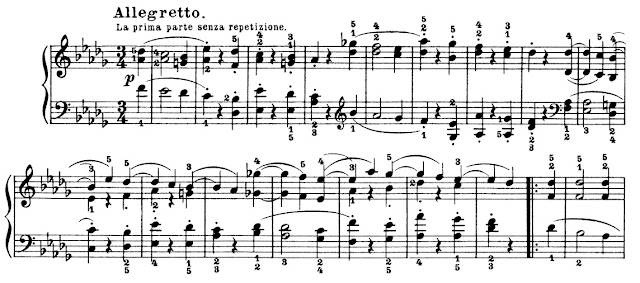 |
| Ludwig Rellstab |
I. Adagio sostenuto - With one of the most recognizable openings of any piece of music, the sonata begins unconventionally with a slow movement. Beethoven gives instructions in Italian under the tempo designation that roughly translates to: This piece needs to be played with the delicacy and without dampers. This means that the right pedal should be held down throughout, thus giving the music a slightly blurred and veiled effect, at least on the pianos of Beethoven's time that had shorter strings and less sustaining of sound. With the modern piano, keeping the pedal down throughout would result in too much harmonic overlap. Modern performers usually opt for more use of the pedal when the harmonies change. The first edition of this sonata is titled Sonata quasi una fantasia. In other words, a sonata that sounds like a fantasia, loose structured and almost improvisatory. The music stays at a very low volume, with the loudest volume being piano.
With the right hand playing not only the triple accompaniment but the melody, it is not an easy piece to play effectively. The low volume and slow tempo along with the two-part writing in the right hand make it a challenge that is the opposite of a flashy, extroverted virtuoso piece. Whether it deserves the nickname of "Moonlight" or not, it is mood music of the most profound.
II. Allegretto - The middle movement is in D-flat major, the enharmonic equivalent of C-sharp major that is usually used to avoid writing in seven sharps. It can be thought of as a type of minuet or a slow scherzo. Either way, it is a buffer between the two outer movements. The middle section is punctuated with szforsandos that lend a scherzo effect to it.
III. Presto agitato - Beethoven's overall plan of this sonata seems to be to turn the structure of a sonata on its head. This sonata was written in 1801 when Haydn was still alive and the makeup of sonata movements were usually fast-slow-fast, with the first movement being the most important. Beethoven's plan is slow-moderate-fast, with the final movement as the most important. The music returns to C-sharp minor with arpeggios that begin in the bass played against a staccato accompaniment. The movement begins with the first measures in the same key sequence as the first movement, but the atmosphere is totally different:
The effect of fierceness is obtained by Beethoven not by using extremes in volume. This movement is peppered with accents and szforsandos with short sections in forte and fortissimo, but mainly this is a movement in relatively quiet dynamics, which adds to the atmosphere of underlying tension that finally breaks free in the last bars. The Moonlight sonata begins with a tone poem that is mysterious and poetic, adds a somewhat trifling middle movement that Franz Liszt described as a Flower between two chasms, and ends with a movement that borders on the edge of violence.




